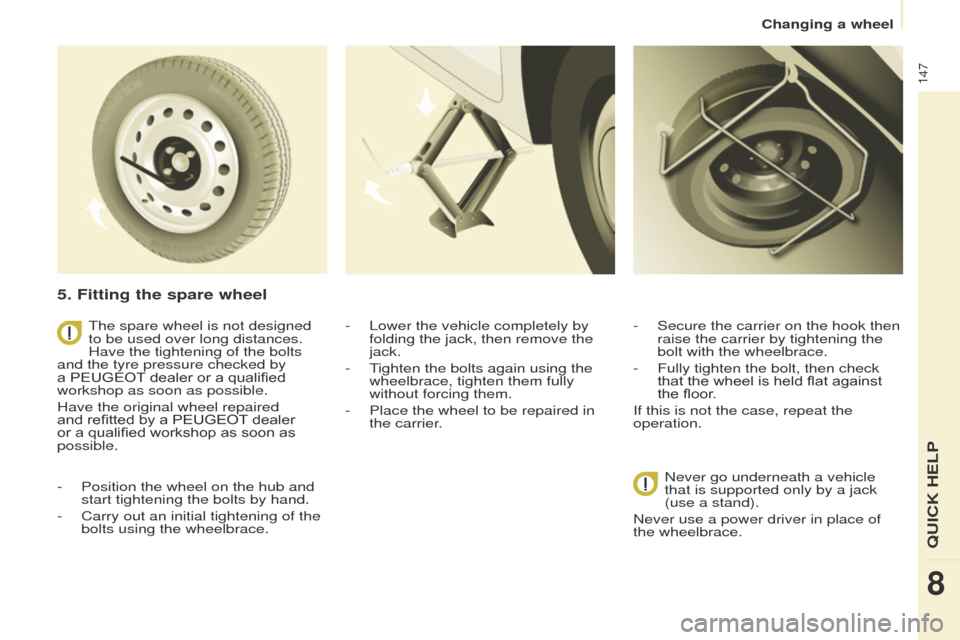Page 147 of 260
145
Partner-2-VU_en_Chap08_Aide-rapide_ed02-2016
2. Tools
The tools are stowed in an open
storage compartment under a front
seat.
-
If necessary
, move the seat to
access the storage compartment
from the rear.
-
T
ake out the jack and tool carrier.
-
Remove the tools needed from the
carrier
.
1.
Jack.
2.
Wheelbrace.
3.
Chock.
4.
Rear lamp spanner
.
5.
Allow wheel trim removal tool*.
6.
T
owing eye.
3. Spare wheel
- Detach the carrier from the hook
and place the spare wheel near the
wheel to be changed.
-
Unscrew the bolt using the
wheelbrace until the carrier is
lowered fully
.
-
Open the rear doors to gain access
to the spare wheel.
QUICK HELP
8
Changing a wheel
Page 148 of 260

146
Partner-2-VU_en_Chap08_Aide-rapide_ed02-2016
4. Removing the wheel with punctured tyre
- Position the foot of the jack on the
ground and ensure that it is directly
below the front or rear jacking
point provided on the underbody,
whichever is closest to the wheel to
be changed.
-
Extend the jack until its head
comes into contact with the jacking
point used; the vehicle's contact
area
A must be engaged with the
head of the jack.
-
Raise the vehicle until there is
sufficient space between the wheel
and the ground, so that the (not
punctured) spare wheel can be
easily fitted.
-
Resume and complete the
unscrewing of the wheel bolts.
-
Remove the bolts and remove the
wheel.
-
Remove the wheel trim.
-
Loosen the wheel bolts and start
unscrewing them. Ensure that the jack is stable, the foot
of the jack must be in contact with the
ground, and directly below the jacking
point used.
If the ground is slippery or loose, the
jack may slip or drop - Risk of injury!
Ensure that the jack is positioned only
at one of the jacking points under the
vehicle, making sure that the vehicle's
contact surface is centred on the head
of the jack.
Otherwise there is a risk of damage
to the vehicle and/or of the jack
dropping
- Risk of injury!
Do not extend the jack until you have
started unscrewing the bolts on the
wheel to be changed and have placed
the chock under the wheel diagonally
opposite.
Changing a wheel
Page 149 of 260

147
Partner-2-VU_en_Chap08_Aide-rapide_ed02-2016
5. Fitting the spare wheel
- Position the wheel on the hub and
start tightening the bolts by hand.
-
Carry out an initial tightening of the
bolts using the wheelbrace. -
Lower the vehicle completely by
folding the jack, then remove the
jack.
-
T
ighten the bolts again using the
wheelbrace, tighten them fully
without forcing them.
-
Place the wheel to be repaired in
the carrier
.
The spare wheel is not designed
to be used over long distances.
Have the tightening of the bolts
and the tyre pressure checked by
a PEUGEOT dealer or a qualified
workshop as soon as possible.
Have the original wheel repaired
and refitted by a PEUGEOT dealer
or a qualified workshop as soon as
possible. -
Secure the carrier on the hook then
raise the carrier by tightening the
bolt with the wheelbrace.
-
Fully tighten the bolt, then check
that the wheel is held flat against
the floor
.
If this is not the case, repeat the
operation.
Never go underneath a vehicle
that is supported only by a jack
(use a stand).
Never use a power driver in place of
the wheelbrace.
QUICK HELP
8
Changing a wheel
Page 151 of 260

149
Partner-2-VU_en_Chap08_Aide-rapide_ed02-2016
SNOW CHAINS
In wintry conditions, snow chains
improve traction as well as the
behaviour of the vehicle when braking.The snow chains must be fitted
only to the driving wheels. They
must never be fitted to "space-
saver" type spare wheels. Take account of the legislation in
force in your country on the use
of snow chains and the maximum
running speed authorised. Advice on installation
F
If you have to fit the chains during
a journey
, stop the vehicle on a flat
surface on the side of the road.
F
Apply the parking brake and
position any wheel chocks to
prevent movement of your vehicle.
F
Fit the chains following the
instructions provided by the
manufacturer
.
F
Move of
f gently and drive for a few
moments, without exceeding
30 mph (50 km/h).
F
Stop your vehicle and check that
the snow chains are correctly
tightened.It is recommended that before you
leave, you practise fitting the snow
chains on a level and dry surface.
Use only the chains designed to be
fitted to the type of wheel fitted to your
vehicle:
For more information on snow chains,
contact a PEUGEOT
dealer or a
qualified workshop. Original
tyre size Maximum link
size.
195/65
R159
mm
195/70
R15
205/65
R15
215/55
R16
215/50
R17Avoid driving with chains on roads
that have been cleared of snow,
to avoid damaging your vehicle's
tyres and the road surface. If your
vehicle is fitted with alloy wheels,
check that no part of the chain or its
fixings is in contact with the wheel rim.
QUICK HELP
8
Snow chains
Page 172 of 260
170
Partner-2-VU_en_Chap09_Caract-technique_ed02-2016
IDENTIFICATION MARKINGS
A. Manufacturer's plate.C. Tyres and paint colour code.
B. Serial number.
This is located on the right-hand
middle pillar.
1 - VF Type serial number.
2 - Gross vehicle weight (GVW).
3 - Gross train weight (GTW).
4.1 - Maximum weight on front axle.
4.2 - Maximum weight on rear axle. This is engraved on the front right
wheelarch.
The label C, on the front door gives:
-
the wheel and tyre sizes,
-
the tyre pressures, laden and
unladen
-
the tyre pressure for the spare
wheel,
-
the paint colour code.The tyre pressures should be
checked when the tyres are cold,
at least once a month.
Identification markings